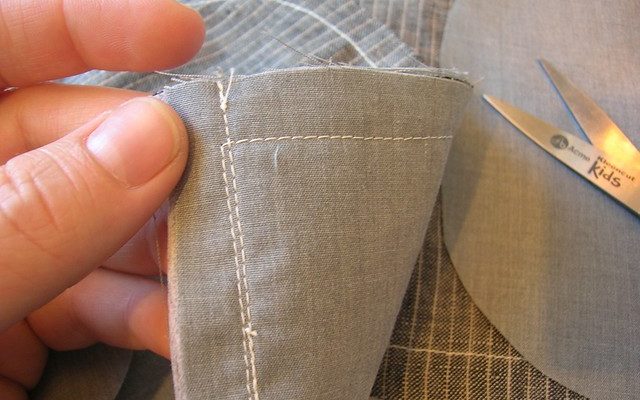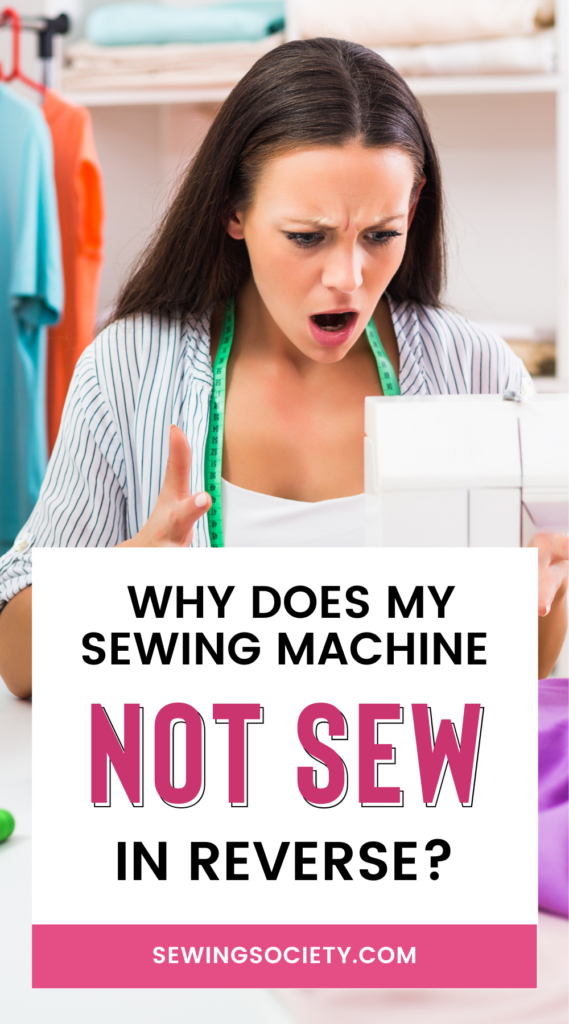Disclosure: This post may contain affiliate links. I earn a small commission when you click a link and make a purchase. Thanks for supporting SewingSociety.com!
The reverse stitch is useful for reinforcing seams and securing the ends of your threads. It’s frustrating when your sewing machine won’t create this backstitch. Here are six reasons why your sewing machine can have trouble sewing in reverse, and what to do about each one.
Contents
You Don’t Have a Reverse Sewing Option
Some sewing machines cannot sew in reverse. If you are using a vintage sewing machine, you might not even have a backstitch lever. The location of the backstitch lever is different on every sewing machine. On older machines, the lever is part of your stitch length control. You simply hold up your stitch length control to sew backward. Newer sewing machines have a separate backstitch lever, usually near the bottom right of your machine. Computerized sewing machines have a button you press and hold to sew in reverse.
Your Backstitch Lever Is Broken
Your backstitch lever is durable, but it can break. The spring on your backstitch lever can also get bent. This repair is complex and best taken care of by a sewing machine repair technician.
Your Backstitch Lever Is Jammed
If a loose thread has gotten inside your machine, it can wrap around your backstitch lever and prevent your sewing machine from sewing in reverse. This is rare, but it’s possible for both thread and lint to jam your reverse-stitching mechanism. Open your sewing machine panel and make sure it is clean of thread, lint, and dust.
Your Stitch Is Set to Automatic Lockstitch
You have several options for securing the ends of your thread — backstitching, lockstitching, and tying by hand. Newer sewing machines have an option for automatic lockstitching. When you start to sew, your machine creates a lockstitch at the beginning of your seam, and when you stop sewing, it creates another lockstitch. You won’t be able to sew in reverse if you’ve selected the automatic lockstitch option. Select a regular stitch and this should fix the problem.
Your Stitch Length Is Too Short
Most fabrics require a stitch length between three and four. However, if you’ve been sewing with a shorter stitch length, your backstitch might not work well. Also, if your stitch length is set to 0, your sewing machine won’t sew forward or backward. Make sure you have not bumped your stitch length and made it too short.
Your Stitch Selection Doesn’t Support Backstitching
Some decorative stitches and stretch stitches do not allow you to sew in reverse. This is common with all overcasting stitches and some zigzag variations. Try selecting a different stitch to see if you can sew in reverse or check your user manual for instructions on the stitch you want to use.
Did you find this article helpful?
I can help you solve other sewing machine problems, too! Get a copy of my book, Sewing Machine Problems and How to Solve Them on Amazon.
Your sewing machine is going to give you troubles again.
It’s inevitable…
My troubleshooting book walks you through how to solve the 20 most common sewing machine problems. You’ll be prepared to tackle any problem your sewing machine throws at you. That means more time sewing and less time crying.
The ebook version only costs $2.99. You’d easily pay between $75 and $150 to take your sewing machine to a repair technician. Learn how to do a lot of the sewing machine troubleshooting yourself and save money.
For more information, visit our Sewing Machine Troubleshooting Page.
Share this post on Pinterest!







I have an Elma 3007, serial #9428783. The reverse stitch spring has broken. Can I get a replacement?
hello there: i have a singer sewing machine 491 D200AA i nedd some tips ,the reverse not working, thanks for your help
My sewing machine is a brother innovis 10 anniversary and lately the thread breaks whenever I try to reverse stitch
It uses a reverse stitch button not a lever so I don’t know what to do